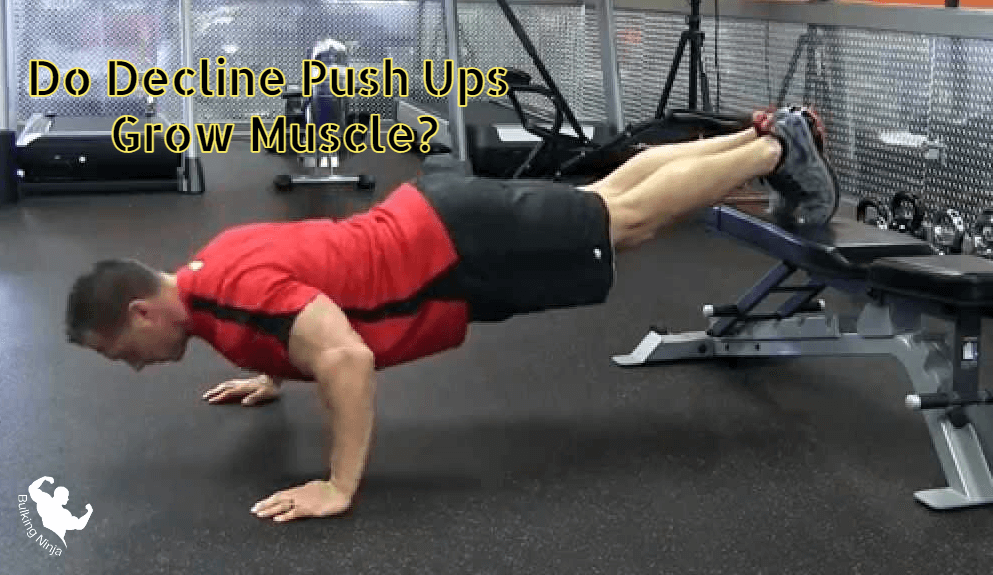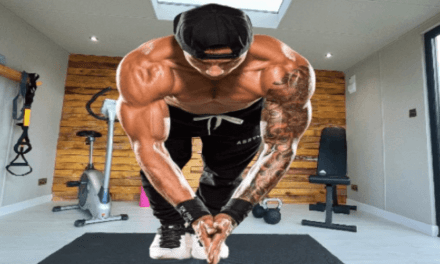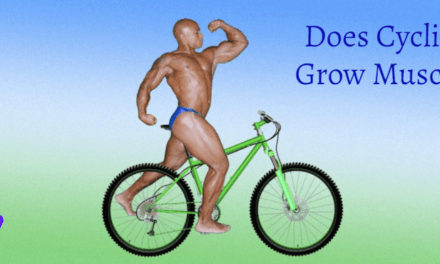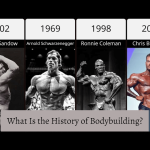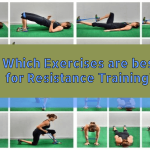If you are on a quest to build muscle and strengthen your upper body, you’ve likely come across various exercises promising results. Among the plethora of options available, decline push-ups have garnered attention for their potential in muscle growth and development.
But the question remains: do decline push-ups truly live up to the hype? In this blog post, we will delve into the science behind decline push-ups and explore their effectiveness in building muscle.
Whether you are a seasoned fitness enthusiast or just starting your fitness journey, understanding the impact of decline push-ups on muscle growth can help you optimize your workout routine and get closer to your strength and physique goals. Let’s uncover the truth behind the claim: do decline push-ups grow muscle?
Table of Contents
- Do Decline Push-Ups Grow Muscle?
- Will Decline Push Ups Build Muscle?
- The Muscle-Building Benefits of Decline Push-Ups
- Decline pushup modifications
- Common Mistakes During Decline Push-Ups
- Frequently Asked Questions
- Will decline push-ups build muscle?
- Are decline pushups harder?
- How many decline pushups should I do to build muscle?
- Do decline push-ups build lower chest?
- Are decline push-ups worth it?
- How many decline pushups is good?
- Which type of pushup is best for chest?
- Which Is Better Push-Ups Or Decline Push-Ups?
- How are decline push up muscles use?
- Which is better incline or decline push-ups?
- Are decline push-ups better?
- Which are decline push ups target muscles?
- What are decline pushups benefits for lower body muscles?
- Do decline push ups build muscle?
- Conclusion
Do Decline Push-Ups Grow Muscle?
When it comes to sculpting a strong and muscular upper body, decline push-ups have been a subject of intrigue and debate among fitness enthusiasts. The question on many minds is, really “Do decline push-ups grow muscle?” Well, the answer lies in understanding the mechanics and decline push up benefits.
Decline push-ups involve elevating the feet on a platform higher than the hands, creating an incline that targets the upper chest, shoulders, and triceps. This positioning places additional resistance on the targeted muscles, making each repetition more challenging.
As a decline push ups results, an effective tool in building muscle and strength in the upper body. In this blog post, we will explore the science behind decline push-ups, the muscles they engage, and how they contribute to muscle growth.
Whether you are a fitness enthusiast looking to add variety to your workouts or someone curious about the potential benefits of decline push-ups, read on to discover the truth about this exercise and its impact on muscle development. Let’s delve into the world of decline push-ups and unlock the secrets to achieving a more muscular and well-defined upper body.
What Is Decline Push Ups
Decline push-ups are a variation of the traditional push-up exercise, where the feet are elevated on a platform higher than the hands. This positioning creates a decline angle, with the upper body positioned at a lower level than the lower body. The decline push-ups primarily targets the upper chest, shoulders, and triceps, putting additional emphasis on these muscle groups compared to regular pushups.
To perform a decline push-up, place your hands on the ground shoulder-width apart and extend your legs back, placing your feet on an elevated surface, such as a bench or sturdy platform. The body should form a straight line from head to heels. Lower your chest towards the ground by bending your elbows, and then push back up to the starting position.
The decline angle in this exercise increases the resistance and makes each repetition more challenging, making it an excellent choice for individuals looking to build muscle and strength in the upper body. Decline push-ups can be incorporated into your regular workout routine or combined with other push-up variations to target different muscle groups effectively.
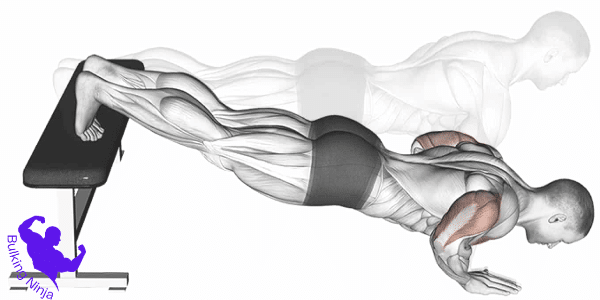
How to Do it
Incorporating decline push-ups into your workout routine can be a game-changer for muscle growth. To perform this exercise, you’ll need a raised surface like a bench, box, or chair. The higher the surface, the harder the exercise becomes, allowing you to progressively challenge your muscles.
If you’re new to decline push-ups, start with a lower surface, like a curb or step, and gradually increase the height over time. Kneel down with your back to the bench, placing your hands on the floor with shoulders over wrists and elbows at a 45-degree angle.
As you lower your chest towards the floor, engaging your core, glutes, and quads, you’ll feel the muscles in your chest, shoulders, and triceps working intensely. Pushing into the floor to return to the starting position effectively targets the muscles in your upper body.
Completing 2 to 4 sets of 8 to 20 repetitions will provide optimal muscle stimulation and growth. However, it’s crucial to listen to your body and stop the exercise if you experience any pain in your wrists, elbows, or shoulders. Proper form and gradually increasing the intensity will ensure a safe and effective muscle-building experience with decline push-ups. Let’s Start Your Bulking Journey with muscles gain mass from Rowing.
Will Decline Push Ups Build Muscle?

Decline push-ups have been a subject of intrigue and debate among fitness enthusiasts. The question on many minds is, “Do decline push-ups really grow muscle?” Well, the answer lies in understanding the mechanics and benefits of this exercise.
Decline push-ups involve elevating the feet on a platform higher than the hands, creating an incline that targets the upper chest, shoulders, and triceps. This positioning places additional resistance on the targeted muscles, making each repetition more challenging. As a result, decline push-ups can be an effective tool in building muscle and strength in the upper body.
Whether you are a fitness enthusiast looking to add variety to your workouts or someone curious about the potential benefits of decline push-ups, read on to discover the truth about this exercise and its impact on muscle development. Read more about what are The benefits of Dumbbell Bench Press Exercise.
The Muscle-Building Benefits of Decline Push-Ups
Decline push-ups offer a powerful and effective approach to strengthening key muscle groups in the upper body. By targeting the upper chest muscles, arms, and shoulders, this dynamic movement delivers substantial benefits for muscle growth and overall upper-body strength. Let’s explore the science behind decline push up benefits and how they contribute to muscle development. Read more about what are The benefits of Dumbbell Bench Press Exercise.
Engaging the Upper Chest Muscles and Shoulders
During decline push-ups, the arms push up and away from the torso, focusing on the upper chest muscles (upper pecs) and the muscles in the shoulders. This targeted engagement allows for concentrated and effective muscle stimulation, making decline push-ups an exceptional exercise for developing a strong and defined upper chest and shoulder region.
Optimizing Muscle Growth through Proper Movement
The movement involved in decline push-ups activates a variety of muscles, including the arms, upper pecs, and other supporting muscles in the torso. This comprehensive muscle engagement leads to efficient and balanced muscle development, creating a more symmetrical and sculpted upper body.
Strengthening Overall Upper-Body Strength
Consistently performing decline push-ups can lead to a notable increase in overall upper-body strength. This enhanced strength is essential for everyday activities, such as carrying groceries or a backpack, making daily tasks more manageable and effortless.
Incorporating Decline Push-Ups Regularly
To reap the full benefits of decline push-ups, incorporating them into your regular workout routine is crucial. Whether you are a fitness enthusiast seeking muscle gain or someone looking to enhance upper-body strength, making decline push-ups a regular part of your exercise regimen can yield significant results.
Decline pushup modifications

Modifying Decline Pushups
Decline pushups offer a fantastic opportunity to challenge and develop your upper body strength. However, not everyone is at the same fitness level, and that’s where modifications come into play. By making adjustments according to your preferences, goals, and capabilities, you can enjoy the decline push up benefits in various ways. Let’s explore the different variations and discover how you can tailor this exercise to suit your needs.
-
Making it Easier: Utilizing a Low Bench or Step
If you find decline pushups too challenging at first, don’t worry; there’s a way to ease into it. Utilize a low bench or step that’s just an inch or two off the ground. This modification reduces the decline angle and makes the exercise more manageable as you build strength.
-
Make it Harder: Elevating Your Feet
Once you’ve mastered regular pushups and want to step up the intensity, consider elevating your feet on a higher surface. This adjustment increases the decline angle, placing more emphasis on the upper chest, shoulders, and triceps. For advanced practitioners, doing wall pushups by placing feet on a wall is another option to challenge the upper body further. Read more about handstand Pushups.
-
Introducing Variations to Level Up
To add excitement and variety to your decline pushup routine, try incorporating the following variations:
-
One-leg pushups
Lift one leg while doing decline pushups, then alternate to complete a set.
-
One-arm pushups
One-arm pushups, Place one arm behind your back to intensify the challenge.
-
Stability ball pushups
Put your hands on a stability ball instead of the floor, engaging arms and core for balance.
-
Knee tap pushups
After each pushup, bend your knee toward your elbow, alternating sides during sets.
-
Dumbbell pushup rows
Dumbbell pushup rows, Place each hand on a dumbbell and, after a pushup, pull one dumbbell upward, repeating on the other side.
-
Clap pushups
Explosively push up while keeping your body straight, clap in mid-air, and land gently.
Exploring Advanced Moves with Caution
These modifications are advanced and may require some practice. Before attempting them, it’s essential to master basic pushups and understand proper form. For personalized guidance and to ensure safe execution, consider consulting a personal trainer who can offer one-on-one support and help you progress at your pace.
In short words, modifying decline pushups allows you to tailor your workout experience and effectively target specific muscle groups. Whether you’re a beginner looking to build strength gradually or an advanced fitness enthusiast seeking new challenges, these variations offer a range of possibilities to achieve your fitness goals. Embrace the flexibility of decline pushups and discover the excitement of a customized workout routine. more read Wall push ups for build muscles.
Common Mistakes During Decline Push-Ups
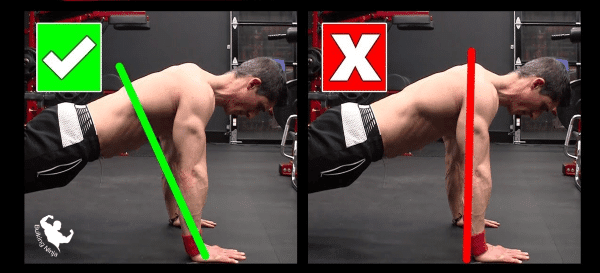
Incorrect Hand Placement
Placing your hands too wide or too narrow can lead to instability and strain on your wrists, reducing the effectiveness of the exercise. Ensure your hands are aligned with your shoulders for optimal support.
Sagging Hips
Allowing your hips to drop during the movement places unnecessary stress on your lower back and reduces the engagement of your core muscles. Maintain a straight line from your shoulders to your heels throughout the exercise.
Overarching Lower Back
While performing decline push-ups, avoid excessive arching of your lower back. This can lead to discomfort and potential injury. Keep your core engaged and your back in a neutral position.
Incomplete Range of Motion
Not lowering your chest sufficiently towards the bench or floor limits the muscle activation and hinders the full benefits of the exercise. Aim to achieve a full range of motion by bringing your chest close to the surface.
Lifting Hips Too High
Raising your hips excessively can shift the focus away from your upper body muscles and reduce the challenge on your chest and shoulders. Maintain a proper alignment from head to heels throughout the movement.
Speeding Through Repetitions
Performing decline push-ups too quickly sacrifices proper form and reduces muscle engagement. Focus on controlled and deliberate movements to maximize the effectiveness of each repetition.
Neglecting Breathing Technique
Failing to breathe properly can impact your performance and stability. Inhale as you lower your body and exhale as you push back up, maintaining a consistent breathing rhythm.
Straining Neck and Shoulders
Allowing your head to drop or jut forward excessively can strain your neck and shoulders. Keep your neck aligned with your spine and maintain a neutral head position.
Remember, practicing proper form is essential for achieving desired decline push ups results and minimizing the risk of injury during decline push-ups.
Frequently Asked Questions
Will decline push-ups build muscle?
Certainly, the inclined position of a decline push-up intensifies the strain on your chest, triceps, and shoulder muscles, compelling you to exert more force against your own body weight.
Are decline pushups harder?
Yes, decline push-ups are generally harder than regular push-ups because they engage your upper chest and shoulders more and require greater core stability.
How many decline pushups should I do to build muscle?
Here are the step-by-step directions:
- Begin by kneeling down, positioning your back towards the bench.
- Place your hands on the floor, ensuring your shoulders are directly above your wrists and your elbows are at a 45-degree angle.
- Engage your core muscles, tighten your glutes, and contract your quadriceps.
- Initiate the movement by pushing into the floor with your hands, propelling your body upward and back to the initial position. As you do this, extend your elbows fully.
- Aim to perform 2 to 4 sets of 8 to 20 repetitions in each set.
Do decline push-ups build lower chest?
Both versions engage your chest, triceps, shoulders, and back muscles. Yet, due to the angle distinction, the Incline Push Up places greater emphasis on your lower chest and back. Conversely, the Decline Push Up primarily targets your upper chest and front shoulders (deltoids), setting it apart from the regular or incline variations.
Are decline push-ups worth it?
Performing decline push-ups shifts your body into a downward incline, effectively amplifying the load on your upper chest and front deltoids. This not only enhances upper body strength, but also refines your physique and readies your upper body for more advanced maneuvers like the handstand.
How many decline pushups is good?
To commence the decline pushup, initiate with 2–3 sets consisting of 8–20 repetitions. Customize the number of sets and repetitions according to your capability to sustain proper form throughout every set and repetition.
Which type of pushup is best for chest?
The standard push-up stance is effective in developing your chest muscles. Place your hands beneath your shoulders and position your toes on the ground. Ensure your hips are aligned, creating a straight line from head to heels.
As you lower your chest towards the floor, bend your elbows while maintaining the alignment of your hips, preventing them from sagging.
Which Is Better Push-Ups Or Decline Push-Ups?
Decline push-ups are better for engaging the upper chest, anterior deltoids, and shoulders more intensely than regular push-ups.
How are decline push up muscles use?
Decline push-ups primarily target the upper chest muscles (pectoralis major), front shoulder muscles (anterior deltoids), and triceps. Additionally, decline push ups muscles engage the core muscles to provide stability during the exercise. The decline angle shifts more of the workload to the upper chest and shoulders compared to regular push-ups, making it an effective variation for building strength and definition in these muscle groups.
Which is better incline or decline push-ups?
Incline push-ups are better for targeting the lower chest with greater volume, while decline push-ups are more effective for working the deltoids and upper chest with higher resistance.
Are decline push-ups better?
It depends on your fitness goals and personal preferences. Decline push-ups can be more challenging and target different muscle groups compared to regular push-ups, making them better for some individuals.
Which are decline push ups target muscles?
Decline push-ups target muscles are primarily target the upper chest, front shoulders, triceps, and core muscles.
What are decline pushups benefits for lower body muscles?
Decline push-ups primarily target the upper body muscles, specifically the chest, shoulders, and triceps. They don’t provide significant benefits for the lower body muscles, as the focus is primarily on the upper body and core stability. If you’re looking to work on lower body muscles, you should incorporate exercises such as squats, lunges, and leg presses into your routine.
Do decline push ups build muscle?
Yes, decline push-ups can help build muscle, particularly in the upper chest, shoulders, and triceps. Like other variations of push-ups, they provide resistance and load to these muscle groups, which, when combined with progressive overload (gradually increasing the intensity or difficulty of the exercise), can stimulate muscle growth and strength development. However, the extent to which muscle growth occurs depends on factors like your training intensity, frequency, diet, and genetics.
Conclusion
Decline push-ups are a highly effective exercise for growing muscle and boosting overall upper-body strength. By focusing on the upper chest muscles, arms, and shoulders, this versatile movement optimizes muscle development and provides a challenging yet rewarding workout.
Embrace the power of decline push-ups in your fitness journey and experience the transformative impact they can have on your upper body.
